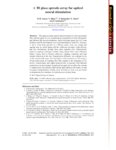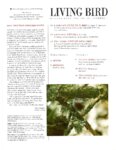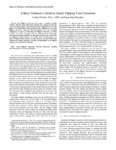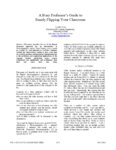Filters: Collection: "ir_uspace"
| Creator | Title | Description | Subject | Date | ||
|---|---|---|---|---|---|---|
| 51 |
 |
Zan Gao | Gao, Z., & Podlog, L<. (2012). Urban Latino Children's Physical Activity Levels and Performance in Interactive Dance Games: Effects of Goal Difficulty and Goal Specificity. Archives of Pediatrics & Adolescent Medicine, 166, 933-937. < | 2012-06-01 | ||
| 52 |
 |
Leslie Podlog | Podlog, L., Kleinert, J., Dimmock, J., Miller, J. & Shipherd, A. (2012). A parental perspective on adolescent injury recovery and return to sport experiences. Journal of Applied Sport Psychology, 24, <.< | 2012-03-01 | ||
| 53 |
 |
Morse, Michael David | ???X??+ band systems of jet-cooled ScCo and YCo | Rotationally resolved resonant two-photon ionization (R2PI) spectra of ScCo and YCo are reported. The measured spectra reveal that these molecules possess ground electronic states of 1?+ symmetry, as previously found in the isoelectronic Cr2 and CrMo molecules. The ground state rotational constant... | 2010 | |
| 54 |
 |
Morse, Michael David | The ?IIou ?X ???g band system of jet-cooled Ti? | A band of jet-cooled ??Ti? has been located in the near infrared by resonant two-photon ionization spectroscopy. Rotational analysis has shown the band to be an ?? =O* ???=1 transition, which is consistent with the 3??g, ground state proposed by Bauschlicher ef al. [J. Chem. Phys. 95, 1057 ( 1991)]... | 1992 | |
| 55 |
 |
Olivera, Baldomero M. | ?O-Conotoxins inhibit NaV channels by interfering with their voltage sensors in domain-2 | The ?O-conotoxins MrVIA and MrVIB are 31-residue peptides from Conus marmoreus, belonging to the O-superfamily of conotoxins with three disulfide bridges. They have attracted attention because they are inhibitors of tetrodotoxin-insensitive voltage-gated sodium channels (NaV1.8) and could therefore ... | 2007 | |
| 56 |
 |
Miller, Joel Steven | [Cyanil]2 2- dimers possess long, two-electron ten-center (2e-/10c) multicenter bonding | A long, two-electron ten-center (2e-/10c) [8 carbon plus 2 oxygen] bond in diamagnetic dimers of radical-anion tetracyano-1,4-benzoquinoneide (cyanil, [Q]2 2-, is described by B2LYP and CASSCF92,2)/MCQDPT calculations. | Carbon bonds; Cyanil | 2008 |
| 57 |
 |
Dearing, Maria-Denise | [Dearing_Database_Pilot] | [Database deposited March 08, 2013, as part of a pilot project, eResearch Committee, University of Utah.] [This description should include information that explains the dataset in detail in a manner that would be useful to potential reuse. The contact information for the primary investigator should ... | [Creator keywords here.] | 2013-03-08 |
| 58 |
 |
Miller, Joel Steven | [Et4N]2[TCNE]2 (TCNE = tetracyanoethylene) - an example of an exceptionally long 2.827 Ã CC bond | Interest in organic compounds exhibiting unusually long CC bonds has been the subject of several recent studies.1-3 The longest sp3-sp3 C-C single bond reported to date is 1.73 A°,1,2 whereas several [TCNE]22- (TCNE = tetracyanoethylene) dimers have been recently reported to form cation-assisted, l... | Synthesis; Crystal; Solution | 2001 |
| 59 |
 |
Miller, Joel Steven | [MeNC5H5]2[TCNE]2 (TCNE = tetracyanoethylene). Single crystal X-ray and neutron diffraction characterization of an exceptionally long 2.8 Å C-C bond | The reaction of N-methylpyridinium iodide, Mepy+I-, and tetracyanoethylene (TCNE) forms [Mepy]2[TCNE]2, which possesses [TCNE]2 2' with an intradimer C-C bond distance of 2.806(1)Å at 50 K from X-ray diffraction, and 2.801(4)Å at 50 K from neutron diffraction. In the IR it exhibits nChN absorption... | C-C bond; Tetracyanoethylene; Neutron diffraction; X-ray diffraction; Multicenter C-C bonding | 2009 |
| 60 |
 |
Warner, Homer R. | A "Link Trainer" for the Coronary Care Unit | Biomedical Informatics | 1968 | |
| 61 |
 |
Blair, Steven | A 3D glass optrode array for optical neural stimulation | This paper presents optical characterization of a first-generation SiO2 optrode array as a set of penetrating waveguides for both optogenetic and infrared (IR) neural stimulation. Fused silica and quartz discs of 3-mm thickness and 50-mm diameter were micromachined to yield 10×10 arrays of up to 2-... | 2012-01-01 | |
| 62 |
 |
Khan, Faisal Habib | A 5 kW Bi-directional multilevel modular DC-DC converter (MMCCC) featuring built in power management for fuel cell and hybrid electric automobiles | Abstract- A new capacitor clamped modular dc-dc converter with bi-directional power handling capability will be presented in this paper. This inductor-free design is modular, and it is possible to integrate multiple loads and sources simultaneously in the converter. Moreover, this 5 kW dc-dc convert... | 2007 | |
| 63 |
 |
Mathews, V. John | A baseband residual vector quantization algorithm for voiceband data signals | Abstract-In this paper, we present a new approach to the digitization and compression of a class of voiceband modem signals. Our approach, which we call baseband residual vector quantization (BRVQ), relies heavily upon the simple structure present in a modem signal. After the signal is converted to... | 1989 | |
| 64 |
 |
Sekercioglu, Cagan | A birders quide to Turkey | As I write, it is early December and the woods outside my window lay dusted with snow like a holiday card by Currier and Ives. A minute ago, I looked up and caught a glimpse of an adult Cooper's Hawk dashing swiftly through the trees. It swooped up, landed on a branch, then briefly shook its tail an... | 2006-01-01 | |
| 65 |
 |
Mathews, V. John; Schlegel, Christian | A blind adaptive projection receiver for CDMA systems | Abstract - This paper presents a blind and adaptive CDMA receiver that does not require knowledge of the spreading codes associated with users other than the ones of interest. Receivers for synchronous as well as asynchronous transmission by multiple users with error control coding are develope... | 1998 | |
| 66 |
 |
Mathews, V. John; Schlegel, Christian | A blind projection receiver for coded CDMA systems | ABSTRACT This paper presents a blind adaptive CDMA receiver that requires no knowledge of the spreading codes, the delays, and the energy of the received signals associated with the interfering users. Our receiver is based on linear interference cancellation and adaptive interference signal subspa... | 1999 | |
| 67 |
 |
Poeppelmeier, Charles Christian | A boolean sum interpolation scheme to random data for computer aided geometric design | This thesis presents a new imterpolation function for randomly distributed data. The new interpolation function is capable of exactly reproducing quadratic surfaces. The new function is developed, through boolean sum theory, from Shepard's two dimensional interpolation functions and the Barnhill-Gre... | Computer-aided geometric design; CAGD; Barnhill-Gregory; Interpolation functions | 1975 |
| 68 |
 |
Ziegenfuss, Donna | A Busy Professor's Guide to Sanely Flipping Your Classroom | The Flipped Classroom has become a popular teaching method. Students watch video lectures before class, saving class time for active learning (problem solving, demonstrations, applications, etc.). This paper is a useful guide for busy professors who would like to try out the flipped classroom approa... | flipped classroom; inverted classroom; engineering education; teaching electromagnetics; assessment pedagogy | 2019 |
| 69 |
 |
Furse, Cynthia M. | A busy professors guide to sanely flipping your classroom | This paper describes the use of the flipped classroom approach for an Introduction to Electromagnetics course. Video lectures were created on a tablet PC, and uploaded to YouTube. Students watched the videos before coming to class. Class time was used for problem solving strategy (using homework as ... | 2013-01-01 | |
| 70 |
 |
Brunvand, Erik L. | A case for increased operating system support in chip multi-processors | We identify the operating system as one area where a novel architecture could significantly improve on current chip multi-processor designs, allowing increased performance and improved power efficiency. We first show that the operating system contributes a non-trivial overhead to even the most com... | 2005 | |
| 71 |
 |
Balasubramonian, Rajeev | A case for increased operating system support in chip multi-processors | We identify the operating system as one area where a novel architecture could significantly improve on current chip multi-processor designs, allowing increased performance and improved power efficiency. We first show that the operating system contributes a non-trivial overhead to even the most com... | 2005 | |
| 72 |
 |
Panangaden, Prakash | A category theoretic formalism for abstract interpretation | We present a formal theory of abstract interpretation based on a new category theoretic formalism. This formalism allows one to derive a collecting semantics which preserves continuity of lifted functions and for which the lifting functon is itself continuous. The theory of abstract interpretation i... | Formal theory; Theoretic formalism; Lifted functions | 1984 |
| 73 |
 |
Brunvand, Erik L. | A cell set for self-timed design using actel FPGAs | Asynchronous or self-timed systems that do not rely on a global clock to keep system components synchronized can offer significant advantages over traditional clocked circuits in a variety of applications. However, these systems require that suitable self-timed circuit primitives are available for b... | Self-timed systems; Actel field programmable gate arrays; FPGA | 1991 |
| 74 |
 |
Davis, Alan L. | A characterization of parallel systems | a taxonomy for parallel processing systems is presented which has some advantages over previous taxonomies. The taxonomy characterizes parallel processing systems using four parameters: topology, communication, granularity, and operation. These parameters and used repetitively in a hierarchical fash... | Parallel systems | 1980 |
| 75 |
 |
Mathew, Binu K.; Davis, Al | A characterization of visual feature recognition | Natural human interfaces are a key to realizing the dream of ubiquitous computing. This implies that embedded systems must be capable of sophisticated perception tasks. This paper analyzes the nature of a visual feature recognition workload. Visual feature recognition is a key component of a numb... | Visual feature recognition; Human interfaces | 2003-09-03 |
